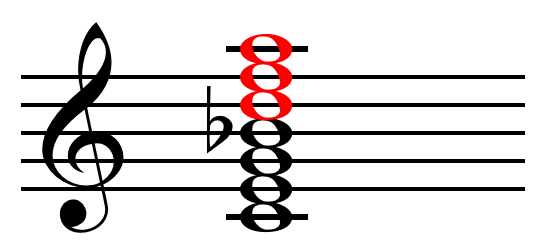Chord Factor on:
[Wikipedia]
[Google]
[Amazon]


 In music, a factor or chord factor is a member or component of a
In music, a factor or chord factor is a member or component of a


 In music, a factor or chord factor is a member or component of a
In music, a factor or chord factor is a member or component of a chord
Chord may refer to:
* Chord (music), an aggregate of musical pitches sounded simultaneously
** Guitar chord a chord played on a guitar, which has a particular tuning
* Chord (geometry), a line segment joining two points on a curve
* Chord ( ...
. These are named root, third, fifth, sixth, seventh, ninth
In music, a ninth is a compound interval consisting of an octave plus a second.
Like the second, the interval of a ninth is classified as a dissonance in common practice tonality. Since a ninth is an octave larger than a second, its ...
( compound 2nd), eleventh (compound 4th), thirteenth
In music or music theory, a thirteenth is the note thirteen scale degrees from the root of a chord and also the interval between the root and the thirteenth. The interval can be also described as a compound sixth, spanning an octave pl ...
(compound 6th), and so on, for their generic interval above the root.
In harmony
In music, harmony is the process by which individual sounds are joined together or composed into whole units or compositions. Often, the term harmony refers to simultaneously occurring frequencies, pitches ( tones, notes), or chords. However ...
, the consonance and dissonance
In music, consonance and dissonance are categorizations of simultaneous or successive Sound, sounds. Within the Western tradition, some listeners associate consonance with sweetness, pleasantness, and acceptability, and dissonance with harshness ...
of a chord factor and a nonchord tone
A nonchord tone (NCT), nonharmonic tone, or embellishing tone is a note in a piece of music or song that is not part of the implied or expressed chord set out by the harmonic framework. In contrast, a chord tone is a note that is a part of the f ...
are distinguished, respectively.Ostransky, Leroy (1977). ''Understanding Jazz'', p. 91. .
Chord factors are taken into consideration in voicing and voice leading. A chord contains exactly as many factors as it contains unique pitch names (octaves don't matter), while a voicing can have any number of voices that draw from and represent some or all the factors of a chord in various octaves. Thus, a chord with three unique pitch names always has three factors, even if some of those pitches are doubled or omitted in a particular voicing. For example, the figure to the right shows a four-note voicing of a C Major triad, which has three chord factors. The "root" chord factor (pitch name "C"), is represented twice in the voicing by voices 1 and 4 in different octaves. The chord factor called the "fifth" (pitch name "G") is represented in voice 2 (shown in red).
The chord factor that is in the bass
Bass or Basses may refer to:
Fish
* Bass (fish), various saltwater and freshwater species
Music
* Bass (sound), describing low-frequency sound or one of several instruments in the bass range:
** Bass (instrument), including:
** Acoustic bass gui ...
determines the inversion of the chord. For example, if the third is in the bass it is a first inversion chord ( figured bass: ) while if the seventh is in the bass the chord is in third inversion (). The illustration shows one possible four-note voicing of a G7 third-inversion chord (written G7/F in lead-sheet chord-symbol notation), with every chord factor being represented once by a voice in the voicing.
In Tertian harmony, chords are made more complex, or "extended", by introducing additional chord factors stacked in thirds. The illustration shows the theoretical construction of a C13 chord having seven chord factors, with the "extended" chord factors shown in red. In real applications, it is common practice to omit the eleventh from voicings of a dominant 13 chord, because though being necessary to theoretically derive the thirteenth by stacking on it, the unaltered perfect eleventh clashes with the major third.
See also
* Degree (music) * Sixth chord * Triad (music)References
* {{music-theory-stub